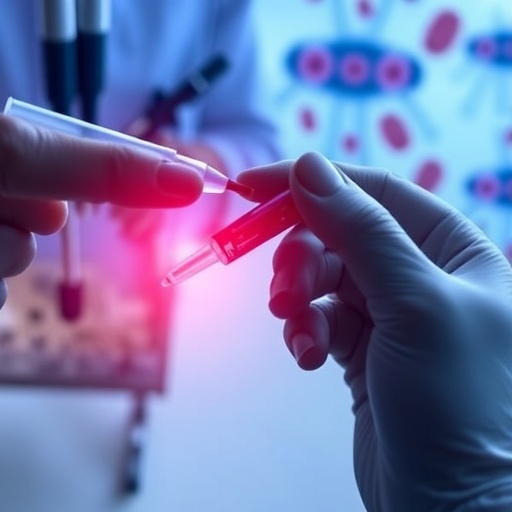In a groundbreaking advancement poised to revolutionize the diagnosis of mitochondrial diseases, researchers have developed a noninvasive method to assess respiratory chain enzyme activity using peripheral blood monocytes. This innovative approach, detailed in a recent study published in World Journal of Pediatrics, promises to circumvent many of the challenges traditionally faced in diagnosing these complex metabolic disorders. By focusing on enzymatic activities within easily accessible blood cells, this technique offers a compelling alternative to invasive tissue biopsies, which have long constrained timely and accurate detection.
Mitochondrial diseases, a diverse group of disorders caused by dysfunctions in the cellular powerhouses known as mitochondria, often present diagnostic dilemmas due to their heterogeneous clinical presentations and the invasiveness of conventional diagnostic procedures. The respiratory chain enzyme complexes within mitochondria are central to cellular energy production, and aberrations in these enzymatic steps underpin many forms of mitochondrial pathology. Traditionally, assessing the functionality of these enzyme complexes required muscle or tissue biopsies, which, apart from being invasive, are often not feasible in pediatric populations or critically ill patients.
The novel focus on peripheral blood monocytes represents a paradigm shift. These immune cells, readily isolated from blood, serve as a surrogate to measure mitochondrial respiratory chain enzyme activity. In their extensive study, Liu, Wang, Zhang, and colleagues have meticulously validated this approach, demonstrating that alterations in enzyme function within monocytes mirror those detected in affected tissues of patients with mitochondrial disease. This correlation opens a new horizon for clinicians, enabling earlier, safer, and more frequent monitoring of mitochondrial function.
.adsslot_XWRMULCexa{width:728px !important;height:90px !important;}
@media(max-width:1199px){ .adsslot_XWRMULCexa{width:468px !important;height:60px !important;}
}
@media(max-width:767px){ .adsslot_XWRMULCexa{width:320px !important;height:50px !important;}
}
ADVERTISEMENT
The study meticulously evaluated the activities of multiple mitochondrial respiratory chain complexes in monocytes obtained from patients suspected of mitochondrial dysfunction. Using sophisticated enzymatic assays and high-sensitivity detection methods, the researchers quantified the functionality of complexes I, II, III, and IV. Their findings revealed significant deficiencies in respiratory chain activity correlating with clinical severity, underscoring the reliability of monocyte-based assessments as proxies for systemic mitochondrial health.
Moreover, this methodological breakthrough is underpinned by its integration with cutting-edge cellular isolation and enzymatic measurement techniques. The ability to isolate monocytes swiftly from peripheral blood, combined with refined spectrophotometric and fluorometric assays, ensures that processing time is minimized, preserving enzyme integrity and activity. This rapid turnaround enhances the feasibility of integrating such tests into routine clinical workflows, potentially expediting diagnosis.
One of the most compelling aspects of this noninvasive diagnostic approach is its scalability and adaptability. Given that peripheral blood draws are standard, minimally invasive procedures, this test could be widely implemented across diverse healthcare settings, facilitating large-scale screening and longitudinal monitoring of at-risk populations. The study’s data suggest that regular assessments could provide dynamic insights into disease progression or therapeutic response, a critical advancement in managing mitochondrial disorders.
From a biochemical standpoint, the research sheds light on the pathophysiology of mitochondrial disease by highlighting how systemic manifestations are reflected at the cellular level within immune components. Given that monocytes are metabolically active and possess mitochondria analogous to those in other tissues, their respiratory chain activities are sensitive indicators of mitochondrial integrity. This also raises intriguing questions about the role of immune cells in the broader phenotype of mitochondrial diseases and potential implications for targeted therapies.
The accessibility of this diagnostic technique could drastically shorten the often protracted journey to diagnosis experienced by mitochondrial disease patients. Historically, diagnosis relied on clinical suspicion followed by invasive sampling, genetic analyses, and sometimes trial therapies, often delaying definitive confirmation. Timely and accurate diagnosis is crucial given the potential for tailored interventions, genetic counseling, and informed prognostication.
Furthermore, the implications of this research extend beyond the pediatric population. While the study emphasizes children, who are disproportionately affected by mitochondrial diseases, the fundamental principles are applicable to older patients with adult-onset mitochondrial pathologies. This universality enhances the potential impact of the assay across lifespan and diverse clinical contexts.
The study also highlights the promising role of peripheral blood monocyte enzymology in differentiating mitochondrial diseases from other metabolic or neuromuscular disorders. By providing a molecular signature of mitochondrial respiratory chain dysfunction, this technique may improve diagnostic specificity, helping to avoid misdiagnosis and inappropriate treatments. It thus represents a valuable addition to the diagnostic armamentarium.
An important consideration addressed by the researchers relates to the technical challenges inherent in enzymatic assays, such as variability in enzyme stability, potential contamination, and standardization across laboratories. The study proposes standardized protocols and quality control measures, ensuring reproducibility and reliability of test results essential for clinical adoption. This attention to methodological rigor reinforces confidence in the diagnostic validity of the approach.
Moreover, the authors envision that integrating this assay with emerging genomic and metabolomic tools could foster a comprehensive diagnostic platform. Combining enzyme activity measurements with genetic mutation panels and metabolic profiling stands to provide a multifaceted understanding of mitochondrial disease etiology and progression. Such integrative diagnostics align with precision medicine goals, tailoring interventions to individual molecular and clinical profiles.
From a research perspective, this innovative diagnostic approach will likely accelerate clinical trials by enabling more accurate patient stratification and monitoring. Patients can be categorized based on biochemical phenotype gleaned from monocyte assays, guiding enrollment and therapeutic targeting. Additionally, serial enzyme activity assessments could serve as biomarkers for therapeutic efficacy, shortening trial durations and enhancing data quality.
In sum, the noninvasive assessment of respiratory chain enzyme activity in peripheral blood monocytes heralds a new era in mitochondrial disease diagnostics. By combining technical sophistication with clinical practicality, Liu and colleagues have charted a path toward improved patient outcomes through timely and accessible molecular diagnostics. The anticipation within the mitochondrial research and clinical communities is palpable as this promising technique moves toward broader implementation and validation.
As mitochondrial diseases continue to challenge clinicians due to their complexity and variability, innovations such as this offer hope not only for better diagnosis but also for unraveling the intricate cellular mechanisms at play. This study exemplifies how translational research bridging cellular biology, enzymology, and clinical medicine can foster breakthroughs with tangible patient benefits. The ripple effects may extend into therapeutic development and personalized medicine paradigms.
Looking forward, ongoing research will be essential to refine this assay, explore longitudinal applications, and evaluate its performance across diverse patient populations and mitochondrial subtypes. Adaptations to accommodate emerging technologies, such as single-cell sequencing and high-throughput enzymatic platforms, promise to further enhance diagnostic resolution. The era of minimally invasive, fast, and reliable mitochondrial diagnostics is on the horizon, and this study marks a significant milestone in that journey.
Subject of Research: Assessment of respiratory chain enzyme activity in peripheral blood monocytes for noninvasive diagnostics of mitochondrial disease
Article Title: Assessment of the respiratory chain enzyme activity in peripheral blood monocytes for the noninvasive diagnostics of mitochondrial disease
Article References:
Liu, JJ., Wang, SM., Zhang, ZH. et al. Assessment of the respiratory chain enzyme activity in peripheral blood monocytes for the noninvasive diagnostics of mitochondrial disease.
World J Pediatr 21, 515–524 (2025). https://doi.org/10.1007/s12519-025-00918-2
Image Credits: AI Generated
DOI: May 2025
Tags: alternative to tissue biopsieschallenges in mitochondrial disease diagnosisenzyme complex functionality testinggroundbreaking medical researchinnovative diagnostic methodsmetabolic disorder assessmentmitochondrial disorder diagnosismitochondrial pathology evaluationnoninvasive mitochondrial disease testingpediatric mitochondrial diseasesperipheral blood monocytes analysisrespiratory chain enzyme activity





